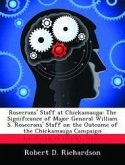This thesis is a historical analysis of Major General Philip H. Sheridan and his division during the Battle of Chickamauga. Sheridan led an experienced division onto the battlefield on 19 September 1863 after completing a march of over one hundred miles over mountainous terrain the previous seventeen days. The division was deployed by brigade to protect the Union right flank. One brigade took heavy casualties the first day, when attacking to repel an enemy advance. On the second day, while moving to reinforce Major General Thomas' corps, the division was routed when Confederate forces attacked through a gap in the Union defense. Sheridan rallied his men, but inexplicably left the battlefield instead of returning to reinforce Thomas' right flank as ordered. Sheridan later moved to reinforce Thomas' left flank, after the battle was over. Sheridan's performance was uncharacteristic for him, particularly his decision to leave the battlefield. Sheridan was not the subject of an official inquiry after the battle, although his actions were similar to other officers who were. Based on the analysis of the division's actions, this study draws conclusions to determine the causes for the unit's poor performance at Chickamauga: poor decision making, fatigue, and piecemeal employment. This work has been selected by scholars as being culturally important, and is part of the knowledge base of civilization as we know it. This work was reproduced from the original artifact, and remains as true to the original work as possible. Therefore, you will see the original copyright references, library stamps (as most of these works have been housed in our most important libraries around the world), and other notations in the work. This work is in the public domain in the United States of America, and possibly other nations. Within the United States, you may freely copy and distribute this work, as no entity (individual or corporate) has a copyright on the body of the work. As a reproduction of a historical artifact, this work may contain missing or blurred pages, poor pictures, errant marks, etc. Scholars believe, and we concur, that this work is important enough to be preserved, reproduced, and made generally available to the public. We appreciate your support of the preservation process, and thank you for being an important part of keeping this knowledge alive and relevant.
Bitte wählen Sie Ihr Anliegen aus.
Rechnungen
Retourenschein anfordern
Bestellstatus
Storno








